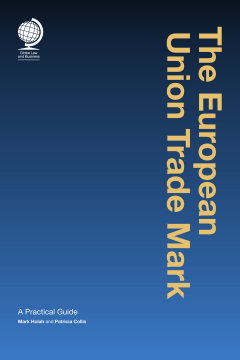
Additional Information
Book Details
Abstract
The European Union Trade Mark (EUTM) system allows brand owners to protect and enforce a trade mark in every EU Member State through just one registration. EUTMs were previously known as Community Trade Marks and this unique trade mark registration system has revolutionised the way brands are protected in the EU.
2016 sees substantial changes to the EUTM system, not least the change of name. This practical guide describes how the EUTM system works following those changes, including: what can be protected; how registrations are obtained and maintained; the many potential obstacles to registration and how to overcome them; and the rights given by a registration. In addition it explains the specific and peculiar features of the EUTM system, such as seniority and conversion, and covers the link between EUTMs and the Madrid Protocol.
'The European Union Trade Mark' will be an invaluable reference tool for anyone involved in brand protection, including trademark attorneys, intellectual property lawyers and in-house counsel working in private practice or in international businesses, both within and outside the EU.
Table of Contents
| Section Title | Page | Action | Price |
|---|---|---|---|
| Front Cover | 1 | ||
| Title | 2 | ||
| Copyright Page | 3 | ||
| Table of contents | 4 | ||
| Preface | 5 | ||
| Glossary | 6 | ||
| Part A: Introduction to the EUTM system | 11 | ||
| 1. Introduction to the Union and the EUTM system | 11 | ||
| 2. The Office | 18 | ||
| 3. Before an application is filed\r | 33 | ||
| Part B: Applications | 40 | ||
| 4. Overview of the EUTM application process\r | 40 | ||
| 5. Basic requirements and formalities\r | 46 | ||
| 6. Classification\r | 60 | ||
| 7. Absolute grounds objections\r | 67 | ||
| 8. Overcoming objections and amendments to applications\r | 89 | ||
| 9. After acceptance\r | 96 | ||
| Part C: Oppositions | 102 | ||
| 10. Overview of the EUTM opposition procedure | 102 | ||
| 11. Basic requirements and formalities\r | 110 | ||
| 12. Relative grounds | 120 | ||
| 13. Submissions and evidence | 136 | ||
| 14. Termination of proceedings | 156 | ||
| Part D: Post-registration | 168 | ||
| 15. Maintenance and amendment | 168 | ||
| 16. Transactions involving EUTM rights | 178 | ||
| 17. Revocation actions | 191 | ||
| 18. Invalidity actions | 209 | ||
| Part E: Appeals | 228 | ||
| 19. Overview and the Boards of Appeal | 228 | ||
| 20. The appeals process | 233 | ||
| Part F: Enforcement | 243 | ||
| 21. Basic principles | 243 | ||
| 22. Infringement | 250 | ||
| 23. Defences and avoiding infringement | 259 | ||
| Part G: Particular features of the EUTM system | 268 | ||
| 24. Seniority | 268 | ||
| 25. Conversion | 275 | ||
| 26. Restitutio in integrum | 282 | ||
| 27. Continuation and interruption of proceedings | 288 | ||
| 28. EU collective marks | 292 | ||
| 29. EU certification marks | 298 | ||
| Part H: International marks\r | 303 | ||
| 30. Introduction to the Madrid Protocol\r | 303 | ||
| 31. The Office as Office of Origin | 311 | ||
| 32. Union designations | 324 | ||
| About the authors | 333 | ||
| Index | 334 |
